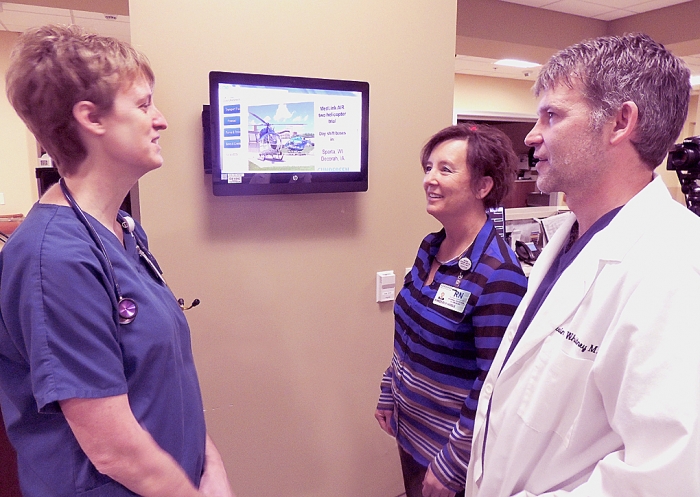Local emergency room handles thousands of visits each year

Exchanging thoughts about the revolutionary new dashboard touch screen in the Crossing Rivers Health emergency room are (from left) Heidi Kirschbaum, ER clinical services director; Kimberly Hable, Gundersen regional services and telemedicine representative; and Dr. Kevin Whitney, ER medical director. (Photo by Correne Martin)
By Correne Martin
The accustomed dramas of doctors, nurses and patients on television aren’t exactly like visiting a real emergency room. Prairie du Chien’s only ER is as high-tech and can be just as fast-paced as the likes of those popular medical shows, but the caregiving team doesn’t have nearly as much spare time for personal dramas.
The Crossing Rivers Health emergency room handles about 9,000 visits a year. The medical staff sees virtually every illness—from sniffles and the flu to a heart attack, stroke and trauma—and proficiently treats its patients in a timely manner.
“In addition to our area residents, we see a large number of tourists in the summer, and they’re often pleased with the high level of care and that they can access quick, efficient, good care in a small town,” said Dr. Kevin Whitney, ER medical director.
“The biggest surprise to people is that it’s quiet in here,” noted Registered Nurse Heidi Kirschbaum, Crossing Rivers’ ER clinical services director. “In the old hospital, all our supplies were in one place. There’s a reason we built it this way.” She explained that, now, each room has its own stock of supplies, so nurses don’t have to pass through the other rooms to retrieve needed equipment and materials. Also, when the current hospital was built, staff requested there be eight rooms in the ER.
“It’s a good thing we did. Our patients enjoy the peace and quiet of the private rooms as well as that level of security, and the rooms are filled several times a week,” Kirshbaum said.
At all times, there are at least two in-house physicians on duty. Doctors rotate in and out of ER patient care on 24-hour shifts, from 8 a.m. to 8 a.m. There are also mid-level providers, nurses, nurse supervisors, surgeons and hospitalists working side-by-side, staffing the ER and urgent care for evenings and weekends. Sharing those responsibilities, about 12-15 Gundersen Tri-State Ambulance paramedics and EMTs rotate being stationed in Crossing Rivers’ ER as well, from 10 a.m. to midnight.
“It’s a win-win for both Crossing Rivers Health and Gundersen Tri-State. When they’re not on call, they’re just sitting at a station, so it might as well be here,” pointed out RN Kimberly Hable, Gundersen regional services and telemedicine representative. “The [Tri-State crew] gains experience and the hospital staff gains the respect necessary to have a nice collaborative relationship.”
“I know them, so I trust them,” Kirschbaum added.
“I enjoy having them. They come with a lot of skillsets and training that is useful in the ER,” Dr. Whitney shared. “We get to know who they are and they’re often taking care of the patients when they go out to meet rural ambulances for transport. So they know our procedures. It’s a good relationship to have.”
Making that connection all the more fortified is the technology at the fingertips of those working in the ER. A revolutionary new touchscreen computer, called a dashboard, is mounted to a wall in the epicenter of the emergency room. There, medical staff can make air and ground requests for medical helicopters and ambulances at the tap of a button. Requests call in to the Gundersen medical command center in La Crosse, where, within five minutes, a paramedic or shift leader returns the call to Crossing Rivers’ ER to obtain a brief synopsis of the medical issue.
“Before, we had to call them and wait on the line. With this (technology), we just run by, hit the button and keep doing what we’re doing,” Kirschbaum stated. “It avoids that time delay and it benefits the patients.”
Dr. Whitney agreed, “Nothing’s worse (when you’re a patient) than when you’re told your going to be transferred (to a larger hospital) and then everybody disappears for 15 minutes. You would rather have your nurse tending to you than being tied to a phone.”
Hable said this equipment was created to develop more streamlined inner-facility operations. “It puts the burden of figuring out transport on [Gundersen’s] shoulders and we have access to more resources.” Especially if, for example, a medical helicopter wasn’t immediately available, Gundersen would facilitate additional calls and wait times in locating one.”
Kirschbaum also pointed out that she can use the dashboard to track the helicopter or ambulance by GPS. She said she can watch the vehicle to see how close they are and find out how long they’ve been in route. “It’s real-time feedback,” she said.
In the case of an ambulance call, the ER staff can additionally pull up critical information on-screen regarding patient care provided on-site or in transit.
“So, if they’ve had an EKG at the home, it gives us time to prepare, which, again, is good for the patient,” Kirschbaum said.
“It helps provide that sense of calmness,” Dr. Whitney cited, noting how important a relaxed atmosphere is in heart-pounding situations.
Such efficiency is key to a well-functioning ER.
In the two trauma rooms specifically, the bed is positioned in the center of the room, where medical staff can easily access the patient from all angles. There’s a ceiling lift in one of the rooms that can transport bariatric patients up to 600 pounds, which decreases work-related injuries for nurses. Plus, the rooms are large enough, with doors that swing open, to accommodate oversized equipment and as many as 12 staff or family members in addition to the patient.
Of the 9,000 patients the Crossing Rivers Health emergency room sees each year, Dr. Whitney said the most common afflictions include chest pain, congestive heart failure, COPD (chronic obstructive pulmonary disease), colds and fevers, gastroenteritis and injuries such as abrasions, fractures and tears.




